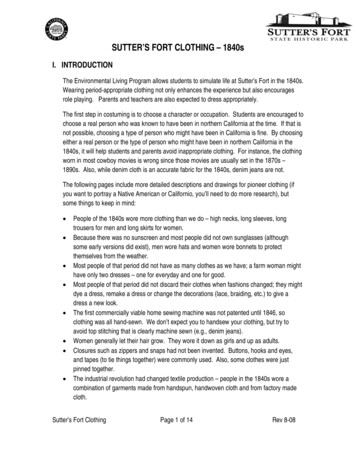
Transcription
2014 LAWTON-FORT SILLECONOMIC REVIEW
SILVER SPONSORTable of Contents1GO OFFENSE, THINK GLOBALby Barry Albrecht, President & CEOLawton-Fort Sill Economic DevelopmentCorporation3ECONOMIC REVIEW ANDOUTLOOKby Mark C. Snead, President/Economist,RegionTrack8THE CITY OF LAWTON11 ECONOMIC DEVELOPMENT16 EDUCATION21 HEALTHCARE24 POPULATION ANDDEMOGRAPHICS27 EMPLOYMENTBRONZE SPONSORS32 COMMERCE36 REAL ESTATE ANDCONSTRUCTION39 BANKING AND BANKRUPTCYFILINGS41 FORT SILL43 AGRICULTURE45 TOURISM49 RENEWABLE ENERGY50 COMMUNITY RESOURCES51 ABOUT THE LAWTON-FORT SILLECONOMIC DEVELOPMENTCORPORATIONPRINTINGA DVA N C E D P R I N T E R SSierraDESIGN & PUBLISHING
2014 LAWTON/FORT SILL ECONOMIC REVIEWGo Offense, Think GlobalTwo years ago, the City of Lawton celebrated a new direction for the city withthe creation of the Lawton Fort Sill Economic Development Corporation (LED).LED’s mission is to attract new capital investment, retain and expand existingbusiness and industries with a focus on high-technology industries, and ensureeconomic growth by recruiting and creating high-quality jobs in the Lawton area.We challenged our organization and the community to “Go Offense, ThinkGlobal,” as we embarked on new missions and new strategies to bring economicgrowth and prosperity to the greater Lawton region.Barry AlbrechtPresident / CEOLawton-Fort Sill EconomicDevelopment CorporationWe designed new strategies with ambitious goals and engaged in exciting andcollaborative partnerships with our local universities and school system. Wecarried our message to industries across the country and world by developing newtools to raise awareness of the advantages of Lawton and Oklahoma. LED is nowengaged in activities that will result in building a robust pipeline of promisingopportunities that will ensure success in achieving our community goals.As a result, “Go Offense, Think Global” has become more than a marketing mantra. It defines who weare and sets the standard by which we measure our success. Today, the energy in our community is tangible.We’re thinking bigger, reaching higher and achieving more than ever before. We are seeing new job growth innew industry sectors and substantial capital investment in retail and health care.With the national defense budget reductions and the ongoing impacts of sequestration, it has becomeobvious that the LED’s priority of diversifying the regional economy is on track. Military communities acrossthe nation, like Lawton, have felt economic effects of sequestration and the impact of reductions to defensespending. This has frozen investment in many communities, but Lawton continues to receive newdevelopments in retail trade, along with hospitality, medical, and business services. The new downtownConvention Center and new Downtown Redevelopment project have captured the attention of developersacross the country.1
2LAWTON/FORT SILL ECONOMIC REVIEW 2014What we see now is just the beginning. It has been a year of strategic growth and evolution for the LED.Our efforts to create and maintain a competitive business environment are also backed by a passionate groupof investors who believe, as we do, in the power of collaboration and the importance of promoting theeconomic vitality of our region. As the direction of the organization took shape, so did a foundation of localindustry experts with a passion for economic development and a firm belief in the potential of this greatOklahoma community.Over the next year, we will continue working with our public and private partners to expand the region’sinfluence and profile both domestically and internationally. We will bolster our message to industries in highcost states with new data points that show that we offer a value proposition to industry that these companiescould substantially benefit from, by moving some or all of their operations to the greater Lawton community.LED will both pursue familiar routes and pioneer untraveled paths to achieve our community goals. Wewill maintain and augment our core work in business development, embedding ourselves even further intonew economic development markets while also expanding our attention to the suppliers of our existingindustries. We will uphold and redefine our expert research competencies, building on our marketintelligence program and advising state leaders on economic development programs while also forging planswith community leaders to design a regional science and technology initiative. We will keep and push ouredge in marketing and communications, diving deeper into the technology side of our online platforms.The city of Lawton is experiencing economic momentum with new jobs and new employers, and theLawton Fort Sill Economic Development Corporation will continue to initiate the actions required toaccelerate this momentum.We will keepand push our edge inmarketing andcommunications, divingdeeper into thetechnology side of ouronline platforms.
2014 LAWTON/FORT SILL ECONOMIC REVIEWEconomic Review and OutlookLawton Growth Strong but Uneven in National RecessionThe Lawton area economy carried tremendous momentum into the recentnational recession, driven by BRAC-related expansion at Fort Sill. Measured bytotal wage and salary employment, the region seemingly ignored the recession asstrong hiring in the military, federal civilian government, and local governmentsectors more than offset private sector job losses. From early 2007 to early 2010,Lawton managed to add nearly 3,000 net new civilian jobs (8 percent gain) whilethe nation languished in recession. Local job gains occurred in several key privatesectors during the national recession, including construction, health care, andaccommodation and food services.Despite overall job gains driven by strength in the Federal sector, the privateside of the local economy suffered significant job losses during the nationalRegionTrackrecession, particularly in manufacturing, financial services, retail and wholesaletrade, and state government. These same sectors were among the hardest hit nationally. Comanche Countysuffered private sector job losses of -0.6 percent (185 jobs) in 2009 and -0.9 percent (260 jobs) in 2010. Thelocal unemployment rate increased steadily from 3.5 percent in early 2008 to near 7 percent by early 2010.Retail sales showed early signs of weakness with a small decline of -0.1 percent for all of 2009 after posting arobust 7.6 percent gain in 2008.Mark C. SneadPresident/EconomistFederal Spending Cuts Push Lawton into RecessionThe broader Lawton economy eventually slumped in 2010 as the private sector was undercut further bya sharp reversal of the prior gains in Federal civilian and military employment. The region slipped intorecession and remained there throughout much of 2011 and 2012 as the nation moved into recovery.Civilian wage and salary job losses totaled roughly 1,800 (a 4.4 percent decline) between the 2nd quarterof 2010 and 3rd quarter of 2012. The region lost an additional 1,800 military personnel in the same period3
4LAWTON/FORT SILL ECONOMIC REVIEW 2014(12.5 percent of total local military jobs). Thispushed the total job loss in Comanche County toroughly 6.0 percent of combined military andcivilian wage and salary jobs. For comparison, thelocal job contraction was roughly on par with the 6.3percent private sector job loss nationally in therecent recession. Continued contraction in Federal civilianhiring; Flat local government hiring; A continued small share of private sectoremployment in the local economy; and Weak economic conditions in nearby regions.Most private sector job losses in the period wereconfined to finance and insurance; retail trade; transportation and warehousing; accommodation andfood services; and professional and technical services. Finance and insurance was hardest hit among themajor private sectors in both percentage andabsolute terms, posting a 25 percent decline (550jobs) in employment. Conversely, the key construction and health care sectors managed to remain relatively strong and add jobs throughout the slowdown.Each of these factors will work to constrain ouroutlook for Lawton in 2014. Most of the factors arerelated to the role of the government sector in theregion and represent external drag generated fromoutside the region. Each factor is discussed in thefollowing sections.Stabilization of Federal ImpactThe Lawton economy remains heavily influenced by military and Federal civilian governmentactivity. The share of wage and salary jobs inPrivate Sector Rebound UnderwayComanche County held by either military personnelSince Early 2013or Federal civilian workers is currently 30 percent.Clear signs of an economic rebound emerged in Significant progress was made in reducing this shareLawton in early 2013, and the transition to recovery between 1990 and 2005, as the share steadily diminis now underway. A hiring surge began in the 1st ished from about 45 percent to only 30 percent. Thequarter of 2013 in several key cyclical sectors includ- share bounced back to nearly 35 percent in 2010under BRAC-driven changes but has sinceing retail trade; transportation and warereturned to 30 percent. Our modelhousing; real estate; and professional,based forecast suggests that this sharescientific, and technical services. StateClear signs ofis likely to resume its slow long-rungovernment hiring reboundedan economicdecline going forward given cursharply in late 2012 and acceleratrent forecasts for U.S. governmented further in 2013.rebound emerged inspending.Perhaps most importantly,Lawton in early 2013,The large share of Federalgrowth in wage and salary incomeand the transition tosectoremployment dictates thatin the private sector acceleratedrecoveryisnowthepaceat which this activityrapidly beginning in the 4th quarterstabilizesandreturns to growth willof 2012. Wage growth (ex-military) inunderway.influencethelevelof overall economicLawton is estimated to reach a robust 7.4activityintheregionin 2014. Greatpercent for all of 2013.uncertaintyremainsoverboththelevel of FederalRetail sales in Comanche County also bottomedspendinggoingforwardandtheeventualdegree ofin early 2013, with sales growth exceeding a 10 ent annual rate in the 3rd and 4th quarters of 2013.suggestthatbothsectorshavelimitedshort-runThe 4th quarter rise represents the region’s first yeargrowth prospects and will likely provide littleover-year retail sales gain in the recovery.meaningful economic stimulus to the Lawton areaPeriodic layoffs have continued to introduce economy in 2014. Any errors surrounding thesenoise into the recovery, but the stage was firmly set in forecasts are also expected to be to the downside.2013 for continued recovery and expansion in theFor the military sector, earnings both in LawtonLawton region in 2014.and statewide bottomed in 2012 and returned toonly a slow pace of growth in early 2013. While theGrowth Will Remain Moderate inreturn to growth in military earnings provides acritical underpinning for the overall recovery of theLawton in 2014While the recovery is solidly underway in the region in 2013 and 2014, forecasts for militaryLawton region, several factors suggest that it may be spending and personnel counts through 2015suggest that any short-run bounce back large enoughmuted somewhat in 2014. These factors include:to stimulate 2014 growth is highly unlikely. Limited growth prospects in the militarysector;
2014 LAWTON/FORT SILL ECONOMIC REVIEWFederal civilian government hiring is only roughly one-third the level of military hiring but the sectorremains comparatively weaker. Employment collapsed in late 2010 and remains down by roughly 500-700jobs since 2010. This represents a more than 10 percent decline (adjusted for 2010 Census workers) with noclear evidence yet of a bottom in hiring. Wages earned by Federal civilian workers have shown limited signsof recovery with an estimated 3.3 percent gain for 2013.The concern over weakness on the Federal side is heightened by the growing economic potential of thisactivity in recent years. The strong economic impact on the local economy of both the recent BRAC-drivenexpansion and the ensuing contraction of Federal activity serve as clear evidence of its influence.In fact, when measured by the level of employee compensation earned in the region, the economicinfluence of Federal-related employment has increased significantly the past decade. Total militarycompensation reported in Lawton (and statewide) more than doubled between 2001 and 2011, despite thenumber of military personnel in Lawton (and statewide) declining by about 10 percent. Reported averageannual compensation jumped from about 35,000 to more than 70,000 per military personnel in ComancheCounty. A similar jump in compensation has taken place for Federal civilian government workers in Lawtonthe past decade, with average compensation rising nearly two-thirds, from 31,000 in 2001 to more than 50,000 in 2011.Protracted overall weakness in the Federal sector suggests that it will not provide meaningful economicstimulus to the region in 2014. Our forecast suggests that 2015 is the earliest the Federal sector could play arole in accelerating the pace of activity in Lawton.Changing Structural Influence of the Government Sector on LawtonA related concern for the 2014 Lawton outlook is the region’s heavy overall concentration ofgovernment-related employment. There are currently only slightly more private sector jobs (29,238/52percent) than government-related jobs (26,592/48 percent) in Comanche County. This is a remarkably highshare of government employment, even among regions with large military installations.Private service-providing firms currently comprise only 42 percent of wage and salary employment, withprivate goods-producing firms employing 10 percent. The low share of private sector activity naturallyconstrains its ability to support a broad-based recovery in the region in periods when the government sectorsare broadly weak.Currently, hiring at all levels of government except state government remains weak, with stategovernment the smallest sector with only about 1,600 workers. Local government, however, is a largeemployment sector with more than 8,300 workers but has added no net new jobs since mid-year 2010. Thesector represents nearly 15 percent of local wage and salary employment and continues to act as a drag onoverall employment in the region.While the share of private sector activity in the region is likely to change only slowly, significant progresshas been made the past two decades. The current 52 percent share for private wage and salary employmentrepresents significant improvement over the 42 percent share as recently as 1990. Further reduction in thegovernment share of local employment going forward will only enhance the ability of the private sector tosway overall economic conditions.Regional Weakness Hampers Lawton RecoveryThe slow pace of activity in the region surrounding Lawton may also work to constrain the pace ofrecovery locally in 2014. The local economy will have to work against economic drag from weak economicconditions in the southwest quadrant of the state.Along with the eastern edge of the state, the southwest portion of Oklahoma has experienced the weakestoverall economic conditions during the recovery. A number of counties adjacent to Comanche, includingCaddo, Kiowa, Tillman, and Cotton, have all experienced extended economic weakness since the staterecovery began in early 2010. A dominant reason for the underperformance is limited exposure to oil and gasactivity relative to other areas of the state. Other common threads include low per-capita incomes, weak retailmarkets, and long-run population declines.Nearby Jackson County (Altus) has similarly experienced significant military and Federal civilian cuts,as well as a decline in private sector employment totaling nearly 15 percent since the onset of the nationalrecession. Jointly, these nearby regions will likely exert some economic drag on the broader regional economy5
6LAWTON/FORT SILL ECONOMIC REVIEW 2014next year. A strong overall recovery in Lawton is unlikely to take hold until economic growth stabilizes acrossthese neighboring markets.2014 Outlook Calls for Further Moderate Growth Led by Private Sector HiringOur outlook for 2014 calls for a continuation of the recovery that took hold in the region in 2013.Despite a number of external and structural factors holding back the pace of growth, the Lawton area ispoised to expand at a healthy but moderate pace in 2014. Overall, the forecast suggests a solid recovery in theprivate sector offset by continued economic drag from most levels of government reflects essentially a reversalof conditions that were in place early in the slowdown.Local civilian wage and salary job growth is estimated to reach 2.0 percent (800 jobs) for all of 2013 beforeeasing to 1.4 percent (600 jobs) in 2014. This represents a sharp reversal of wage and salary job losses of -1.1percent in 2011 and -1.2 percent in 2012. Total civilian wage and salary employment should return by year-endto roughly the peak set in 2010.Our forecast anticipates a measureable decline in the local unemployment rate during 2014, from themost recent rate of 6.3 percent in December 2013 to near 5.3 percent by year-end. Little progress has beenmade to date on reducing the jobless rate, but it is well-known to respond with an extended lag to changes inbroader economic conditions.Retail sales in Comanche County are forecasted to post a moderate 4.1 percent year-over-year gain in2014 and should ease some of the pressure on local government finances. This would represent the largestannual gain in local retail sales since the slowdown began in 2010.Lawton Remains on a Unique Economic CycleOur 2014 forecast for Lawton is not highly dependent upon the economic outlook for either the state ornation. Lawton has long had a unique economic cycle that often moves countercyclical to both the nation andstate. The current recession and recovery cycle is no exception. Lawton moved countercyclical to the state inthe recent recession and in both the 1990 and 2001 slowdowns.The Lawton region also exhibits little of the historical ‘energy-state’ cycle that dominates many otherregions of the state. For this reason, the state and national outlook for 2014 are only relevant to the degreethey affect the outlook for Federal and state government employment and spending locally.Government Hiring Mixed, Remains a Constraint in 2014Our forecast calls for local military hiring to fully stabilize in 2013 and increase slightly by about 100personnel (1.1 percent gain) in 2014. This will push the estimated number of local military personnel toapproximately 12,900. Federal civilian payrolls are expected to remain constrained by tight budgets andcontinue to decline through 2014 by about 300 additional workers. The expected Federal civilian loss willlikely more than offset any small gain in military personnel.Local government payrolls have remained flat since 2011 but are expected to rise for the first time in therecovery in 2014. Wage income in the sector accelerated rapidly beginning in early 2013, as local governmentsare expected to add 130 jobs (1.7 percent gain) in 2014. The expected hiring strength reflects the broadeconomic recovery underway locally.State government hiring in Comanche County surged 4.6 percent (60 jobs) in 2012 and 6.2 percent (90jobs) in 2013. This is typical of the hiring pattern in most counties across the state with a high concentrationof state employees. State government hiring is expected to ease to 1.7 percent (25 jobs) in 2014 as delayedhiring during the recession is exhausted. For overall government-related hiring, weakness in Federal civilianhiring is expected to offset any expected gains in all other areas of government in 2014.Local Goods-Producing Sectors Provide Stability in 2014Much like the government sectors, Lawton’s goods-producing industries should return to stability in2014 but are not expected to be a major source of hiring.The construction sector was supported by a significant local building surge throughout the slowdownbut underwent a late restructuring in 2013 that pushed employment in the sector lower by an estimated 7.3percent for all of 2013. We anticipate a slight rebound in 2014 with modest growth in construction jobs of
2014 LAWTON/FORT SILL ECONOMIC REVIEW2.0 percent (35 jobs), a rate more consistent with the overall pace of recovery in the region. A number ofongoing projects will work to provide a floor to construction hiring in 2014.Employment in Lawton’s large and critical manufacturing sector declined by 15 percent (600 jobs)during the national recession and has recovered only about one-third of the jobs at this point. Whilemanufacturing output continues to rise at both the state and national levels, gains in manufacturingemployment showed tremendous fatigue in both 2012 and 2013. The U.S. manufacturing sector is expectedto face an uphill battle as a source of significant job growth in 2014 and 2015, both nationally and locally. Ourforecast for Lawton calls for an estimated gain in factory jobs of 1.1 percent (40 jobs) in 2013 to be followedby modest growth of 0.7 percent (25 jobs) in 2014. Local factory jobs are expected to remain roughly 10percent below the recent 2007 peak at year-end 2014.Unlike most counties across the state, oil and gas activity will provide little economic boost to the Lawtonregion in 2014. More than 50 of the state’s 77 counties derive at least 3 percent of local wage and salaryincome from oil and gas activity. However, in Comanche County, only about 100 jobs are in the mining sectorand they contribute only 0.4 percent of total wage and salary income. While the region has historically beeninsulated against negative shocks from the oil and gas industry, Lawton remains locked-out of the largeeconomic gains generated by the sector in many areas of the state the past decade.Service-Providing Sectors Create Most New JobsThe service-providing sectors should build upon the rebound that emerged in 2013 and provide the bulkof the net new hiring in the Lawton region in 2014.Perhaps the clear standout in the recovery to date is the hard-hit professional, scientific, and technicalservices sector. After losing 400 jobs in the downturn, the sector posted a 10.2 percent gain (100 jobs) in 2012,and an estimated 19.9 percent gain (225 jobs) for all of 2013. A major new employer in the region representsmuch of the 2013 gain. Our forecast calls for the surge in hiring to ease in 2014 to a 2.2 percent gain, but thesector should continue to provide many of the highest quality new service jobs in the region.The health care sector lost roughly 300 jobs in the slowdown but has since set new highs with a 3.6 percentgain (125 jobs) in 2012 and an estimated 6.5 percent gain (220 jobs) for all of 2013. Our forecast calls forcontinued strength in the sector driven by implementation of the Affordable Care Act and a hiring gain of 3.5percent (130 jobs) in 2014. Similar strength in health care employment is visible in most counties across the state.The highly cyclical wholesale and retail trade sectors served as a key source of employment early in therecovery and should continue to add jobs as the local recovery matures. Gains will likely ease from the 2.9percent surge estimated for 2013, as our forecast calls for 70 new jobs (1.3 percent gain) in 2014. The relatedtransportation and warehousing sector added jobs at an estimated 15 percent pace (160 jobs) for all of 2013but should similarly ease to a 1.7 percent gain (20 jobs) in 2014.The real estate sector continues to restructure following the housing buildup related to the BRACexpansion and is expected to provide few new jobs in 2014. Extreme hiring weakness in the related financeand insurance sector since the onset of the national recession in 2008 is likely to push into 2014, with ourforecast calling for flat hiring in the sector.Accommodations and food services remain highly cyclical and should continue the rebound started in2013. An estimated 90 new jobs (2.1 percent gain) were created in 2013 and an additional 130 (2.9 percentgain) are expected in 2014.Overall, the private services sectors will serve as the engine of growth in Lawton in 2014 and are expectedto generate nearly all of the 600 net new jobs forecasted for the region.Population Growth Remains IntactRegions that go through protracted economic weakness often experience a related population drain. Thishas not been the case to date with the Lawton area slowdown. Comanche County population growth slowedto 0.3 percent in 2011 and 0.5 percent in 2012, but local population remains up by more than 5 percentbetween the 2009 and 2012 Census estimates. This growth remains much stronger than in most adjacentcounties and the southwest portion of the state.Our model-based estimates suggest further county population growth of 0.6 percent for 2013 and a gainnear 1.0 percent for 2014. Despite recessionary conditions in 2011 and 2012, both the city of Lawton andComanche County likely established all-time highs in population in 2013.7
8LAWTON/FORT SILL ECONOMIC REVIEW 2014The City of LawtonOverviewThe City of Lawton, founded in 1901, is the largest of 10 cities and towns in Comanche County. It servesas the county seat and is the fifth largest city in Oklahoma. At an elevation of 1,150 feet, Lawton is locatedapproximately 90 miles southwest of Oklahoma City along Interstate 44. Fort Sill, an active U.S. Armyinstallation, is located on the city’s north side and is part of city limits as the result of annexation in the 1990s.The Wichita Mountains National Wildlife Refuge is located northwest of Lawton. Average monthlyLAWTON WEATHERMONTHAVG. HIGHAVG. LOW AVG. TEMP. PRECIP. : National Weather Service.
2014 LAWTON/FORT SILL ECONOMIC REVIEWtemperatures range from a low of 26 F in December to a high of 96 F in July. With a population of 98,376 asof 2012, Lawton accounts for nearly 80 percent of the countywide population. The smaller cities and townsof Cache, Chattanooga, Elgin, Faxon, Fletcher, Geronimo, Indiahoma, Medicine Park, and Sterling make upthe remainder.COST OF LIVING COMPARISONSLAWTONOKLAHOMA 0.590.0201297.390.889.2201396.290.388.3Note: The average for all participating places nationwide equals 100 andeach participant’s index is read as a percentage of the average for all places.Source: Council for Community and Economic Research (C2ER), Cost ofLiving Index.Cost of LivingAccording to the Council for Community and Economic Research’s Cost of Living Index (COLI), thecost of living in Lawton was 3.8 percent below the national average in 2013, down from 2.7 percent below in2012. The COLI measures relative price levels for consumer goods and services in more than 300participating areas in all 50 states. The index includes weighted sub-indices for grocery items, housing,utilities, transportation, healthcare, and miscellaneous goods and services.In 2013, groceries, housing, and utilities were less expensive in Lawton than nationwide whiletransportation (gasoline and automobile maintenance), health care, and miscellaneous goods and serviceswere more expensive. Local grocery costs were 13.5 percent below the national average in 2013, down from3.8 percent below in 2012. Housing costs (home prices, rental rates, and mortgage rates) in Lawton were 7.6percent below the national average in 2013, up from 10.6 percent below in 2012. The cost of utilities was 13.5percent below the national average in 2013, down from 6.9 percent below the year prior.Transportation costs in Lawton in 2013 were 8.1 percent higher than the average of nationwideparticipants, down from 11.5 percent higher in 2012. Healthcare costs were 3.4 percent above the nationalaverage, down from 4.9 percent above in 2012.The local cost of miscellaneous goods and services was 0.4 percent above the national average, up from0.8 percent below in 2012.LAWTON COST OF ANSPORTATIONHEALTHCAREMISC.GOODS 86.592.486.5108.1103.4100.4Note: The average for all participating places nationwide equals 100 and each participant’s index is read as apercentage of the average for all places. Source: Council for Community and Economic Research (C2ER), Costof Living Index.9
10LAWTON/FORT SILL ECONOMIC REVIEW 2014Tax RatesSALES TAXThe sales tax rate in Lawton is 4.125 percent, which is added to a base of 4.75 percent, which includescounty (0.25 percent) and state (4.5 percent) rates. The city sales tax funds the city’s general operations, alongwith capital improvement projects and Lawton Pubic Schools. The county sales tax funds economicdevelopment and the county jail.PROPERTY TAXThere are more than 37 different property tax rates in Comanche County depending on the schooldistrict, city, and vocational-technical school district in which the property is located. Rates vary from about 75 to 110 per 1,000 of assessed value. The county applies an assessment ratio of 11.25 percent (for bothreal and personal property) to the market value, with a 1,000 homestead exemption for primary residence.Thus, property valued at 150,000 would have an assessed value of 16,875, reduced to 15,875 after theexemption. Depending on location of the property within the county, annual taxes would r
Lawton-Fort Sill Economic Development Corporation. 2 L A W T O N / F O R T S I L L E C O N O M I C R E V I E W 2 0 1 4 What we see now is just the beginning. It has been a year of strategic growth and evolution for the LED. Our efforts to create and maintain a competitive busin




![The Book of the Damned, by Charles Fort, [1919], at sacred .](/img/24/book-of-the-damned.jpg)





